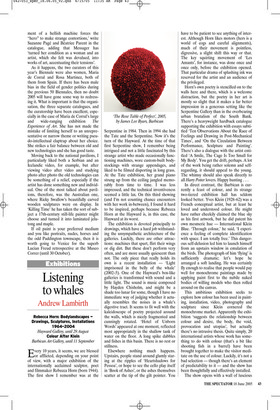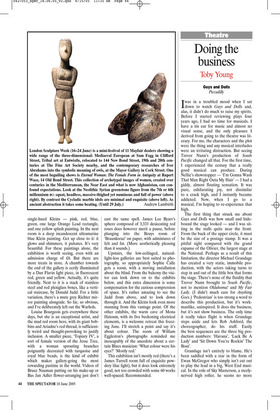Listening to whales
Andrew Lambirth
Rebecca Horn: Bodylandscapes — Drawings, Sculptures, Installations 1964–2004 Hayward Gallery, until 29 August Colour After Klein Barbican Art Gallery, until 11 September Every 10 years, it seems, we are blessed or afflicted, depending on your point of view, with a major exhibition of the internationally acclaimed sculptor, poet and filmmaker Rebecca Horn (born 1944). The first show I remember was at the Serpentine in 1984. Then in 1994 she had the Tate and the Serpentine. Now it’s the turn of the Hayward. At the time of that first Serpentine show, I remember being intrigued and not a little fascinated by this strange artist who made occasionally functioning machines, wore custom-built bodystockings with strange appendages, and liked to be filmed disporting in long grass. At the Tate exhibition, her grand piano strung up from the ceiling jangled memorably from time to time. I was less impressed, and the technical inventiveness seemed a little lax. On this third showing (and I’m not counting chance encounters with her work in-between), I found it hard to be inspired, perhaps because Rebecca Horn at the Hayward is, in this case, the Hayward at its worst.
The exhibition is devoted principally to drawings, which have a hard job withstanding the unsympathetic architecture of the galleries. Luckily, there are other attractions: machines that spurt, flirt their wings or dig dirt. But these don’t perform very often, and are more usually quiescent than not. The only piece that really holds its own is a recent installation — ‘Light imprisoned in the belly of the whale’ (2002–5). One of the Hayward’s box-like galleries is transformed with sound and a little light. The sound is music composed by Hayden Chisholm, and might be a shade too lunar for some, though I have no immediate way of judging whether it actually resembles the noises in a whale’s digestive tract. It seems to fit well with the kaleidoscope of poetry projected around the walls, which is nicely fragmented and cunningly rotated. ‘Hotel of Unborn Words’ appeared at one moment, reflected most appropriately in the shallow tank of water on the floor. A long spike dabbles and fishes in this basin. There is no rest or stillness.
Elsewhere nothing much happens. Upstairs, people stand around glumly staring at the ripples of ‘Heartshadows for Pessoa’, or hope to see the cello play itself in ‘Book of Ashes’, or the ashes themselves scatter at the tip of the gilt pointer. You have to be patient to see anything of interest. Although Horn likes motors (hers is a world of cogs and careful alignments), much of their movement is pointless, digressive, a slight shift this way or that. The key squirting movement of ‘Les Amants’, for instance, was done once and once only, before the exhibition opened. That particular drama of splashing ink was reserved for the artist and an audience of the privileged.
Horn’s own poetry is stencilled on to the walls here and there, which is a welcome distraction, but the poetry in her art is mostly so slight that it makes a far better impression in a generous setting like the Serpentine Gallery than in the overbearing urban brutalism of the South Bank. There’s a heavyweight hardback catalogue supporting the exhibition with essays subtitled ‘Ten Observations About the Race of Feelings and Drawing in Post-Mechanical Times’, and ‘On the Circulation Between Performance, Sculpture and Painting’. There’s also a dialogue with the artist entitled ‘A Smile, The Cage Is Too Small for My Body’. You get the drift, perhaps. A lot of the work being rather solemn and selfregarding, it should appeal to the young. The whimsy should also speak directly to all Harry Potter lovers. Happy hunting ...
In direct contrast, the Barbican is currently a feast of colour, and its strange two-tiered exhibition hall has seldom looked better. Yves Klein (1928–62) was a French conceptual artist, but at least he loved and understood colour. He might have rather cheekily claimed the blue sky as his first artwork, but he did patent his own mesmeric hue — International Klein Blue. ‘Through colour,’ he said, ‘I experience a feeling of complete identification with space. I am totally free.’ This dangerous self-delusion led him to launch himself from an upstairs window in emulation of the birds. The photograph of him ‘flying’ is sufficiently dramatic; let’s hope he arranged a soft landing. He was certainly fly enough to realise that people would pay well for monochrome paintings made by applying paint first to the nubile naked bodies of willing models who then rolled around on the canvas.
This ambitious exhibition seeks to explore how colour has been used in painting, installation, video, photography and sculpture since Klein cornered the monochrome market. Apparently the exhibition ‘suggests the relationship between colour and desire, the body, the void, provocation and utopias’, but actually there’s no intrusive thesis. Quite simply, 20 international artists whose work has something to do with colour (that’s a bit like shooting fish in a barrel) have been brought together to make the visitor meditate on the use of colour. Luckily, it’s not a bad selection — though there’s an element of predictability to it — and the show has been thoughtfully and effectively installed.
The show opens with a wall of luscious single-hued Kleins — pink, red, blue, green, one large Orange Lead rectangle, and one yellow splash painting. In the next room is a deep incandescent ultramarine blue Klein painting. Get up close to it: it glows and shimmers, it pulsates. It’s very beautiful. For these paintings alone, the exhibition is worth seeing, even with an admission charge of £8. But there are more treats in store. A chamber towards the end of the gallery is eerily illuminated by a Dan Flavin light piece, in fluorescent red, green and yellow. Actually, it’s quite friendly. Next to it is a stack of stainless steel and red plexiglass boxes, like a vertical staircase, by Donald Judd. For a little variation, there’s a mute grey Richter mirror painting alongside. So far, so obvious, and I’ve deliberately left out the Warhols.
Louise Bourgeois gets everywhere these days, but she is an exceptional artist, and the mad red room here, with its giant bobbins and Ariadne’s red thread, is sufficiently weird and thought-provoking to justify inclusion. A smaller piece, ‘Topiary IV’, a sort of female version of the Jesse Tree, with a woman sprouting branches poignantly decorated with turquoise and royal blue beads, is the kind of exhibit which makes gallery-going the most rewarding pastime in the world. Videos of Bruce Nauman putting on his make-up or Bas Jan Adler flower-arranging just don’t cast the same spell. James Lee Byars’s sphere composed of 3,333 desiccating red roses does however merit a pause, before plunging into the Beuys room of ‘Braunkreuz’ on paper, with admixtures of felt and fat. (More aesthetically pleasing than it sounds.) Upstairs, the low-ceilinged, naturallight-less galleries are best suited to photography, so appropriately Sophie Calle gets a room, with a moving installation about the blind. From the balcony the visitor can look down on to the exhibits below, and this extra dimension is some compensation for the curious compression of space. It’s rather amazing to see the Judd from above, and to look down through it. And the Kleins look even more stunning from this vantage point. Of the other exhibits, the warm cave of Mona Hatoum, with its five beckoning electrical elements, is a welcome retreat this freezing June. I’ll stretch a point and say it’s about colour. The room of William Eggleston’s photographs reminded me inescapably of the anecdote about a certain Blues musician: ‘What colour were his eyes?’ ‘Mostly red.’ This exhibition isn’t mostly red (there’s a James Turrell room full of exquisite powdery lilac light), but it does look extremely good, not too crowded with some 60 works well-spaced. Recommended.

















































 Previous page
Previous page